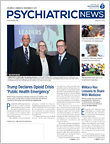Collaborative care has emerged as a proven model for effectively delivering mental health care across a variety of settings, yet this model has not been rigorously tested for treating patients with substance use disorders. A study appearing in the October issue of JAMA Internal Medicine found that implementing collaborative care in a community health setting is both feasible and beneficial for patients with substance use disorders.
“Collaborative care increases the capacity for primary care to deliver evidence-based substance use treatments, and when these treatments are provided, patients get better,” said lead study author Katherine Watkins, M.D., a psychiatrist and senior physician policy researcher at the RAND Corporation in Santa Monica, Calif.
Watkins told Psychiatric News that adapting the collaborative model for substance use disorders is important since primary care physicians may come into contact with people who might not recognize the extent of their disorder and/or that there are treatments available to help them. “Many people with a problem don’t want to identify as an addict, which is required when you visit an addiction specialist,” she said.
The trial involved 377 primary care patients with opioid and/or alcohol use disorders (OAUD) seen at two Los Angeles–area clinics, who were randomly assigned to collaborative care or usual care. Each clinic had therapists trained in behavioral therapy as well as clinicians trained to administer Vivitrol, a long-acting naltrexone injection (for alcohol use disorder), or sublingual buprenorphine/naloxone (for opioid use disorder).
Participants receiving collaborative care were paired with a care coordinator, who regularly met with them and assessed their progress. Participants in the usual care group were told the clinic offered OAUD treatment and were given a phone number for scheduling appointments, but received no other outreach by staff.
After six months, participants in the collaborative care group were more likely than people receiving usual care to receive an evidence-based OAUD treatment (39 percent versus 17 percent) and more likely to be abstinent from opioids or alcohol (33 percent versus 22 percent), the authors reported.
Still, Watkins noted that there is much room for improvement. “Even in the collaborative care group, when offered a treatment, more than 60 percent of patients said, ‘No thank you,’” she said. “That shows we haven’t met their needs. We need to understand their perspective and match appropriate treatments.”
In addition, while patients were more receptive to behavioral therapies, only 13 percent of patients in either group received a medication-assisted therapy like naltrexone (13.4 percent in the collaborative care group and 12.6 percent in the usual care group). There was no difference between the collaborative care and usual care groups in terms of health-related quality of life.
Mark Duncan, M.D., an addiction psychiatrist at the University of Washington (UW) and member of UW’s AIMS Center (Advancing Integrated Mental Health Solutions), said he believes these findings are an important springboard for bringing collaborative addiction care to more clinics and lauded the investigators for developing a comprehensive program.
“This was the closest attempt to replicate the collaborative care model I have seen,” he said. “It took place in a community setting, and they used measurements, used a patient registry, and perhaps most important, took a patient-centered approach.”
He told Psychiatric News that the modest improvements seen in the collaborative care group could be explained in part by the investigators’ efforts to be inclusive in this study and enroll patients who might be more difficult to treat successfully. For example, about half of the participants in the study were homeless; patients with comorbid bipolar disorder or schizophrenia were also included in the trial.
Duncan noted that the medications selected for the trial and the measurements used to assess progress may also have made it more difficult to assess improvements.
“The only medication they offered for alcohol abuse was Vivitrol, which is useful, but oral naltrexone is considered a better first-line treatment,” he said.
The main measurements were self-reports on substance use and the Healthcare Effectiveness Data and Information Set, a consumer-oriented set of benchmarks used to rate the performance of managed-care organizations. Duncan suggested that other objective patient-focused measurements such as urine screenings or participation in therapy groups might be more reliable outcomes to monitor.
“A core component of collaborative care is measurement-based care,” he said. “One of the reasons collaborative care for depression works so well is that the PHQ-9 (a brief screening tool) is a validated measurement across multiple clinical settings that really augments our care.”
This study was supported by a grant from the National Institute on Drug Abuse. ■
An abstract of “Collaborative Care for Opioid and Alcohol Use Disorders in Primary Care: The SUMMIT Randomized Clinical Trial” can be accessed
here.
